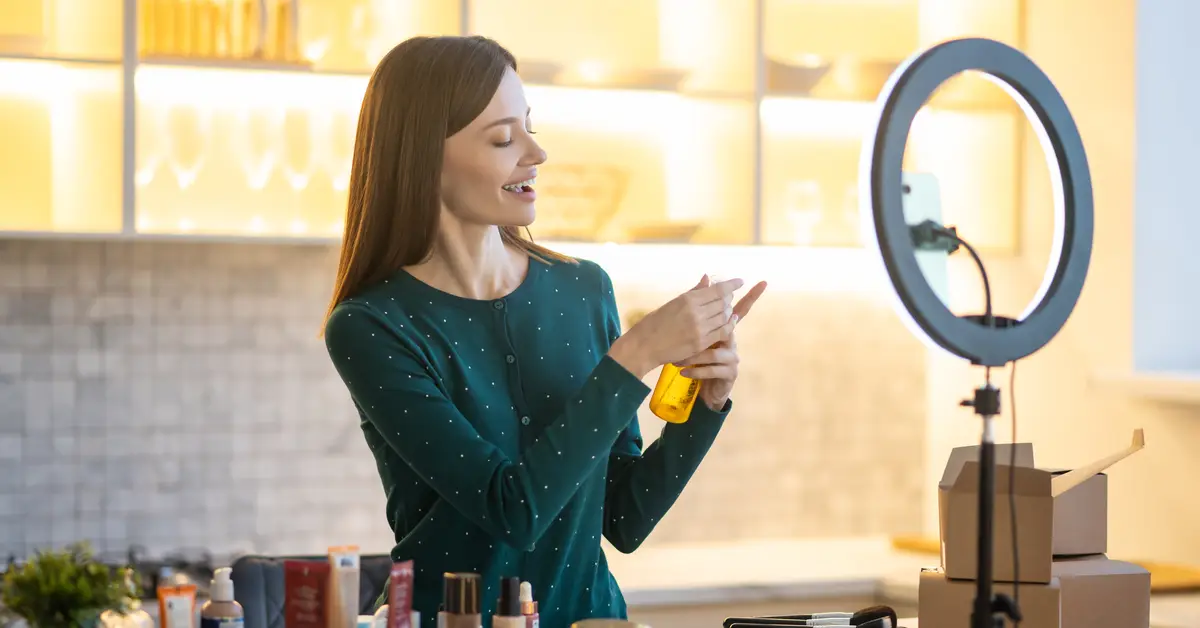Ever since the start of the pandemic, the creator economy has been expanding and growing with record numbers. Between January and September 2021 the creator economy as a term was mentioned 150,000 times online, a x17 increase since 2020.
Talk about growth 📈.
With every lockdown came a new wave of creators, and with more creators, the need for innovative solutions and tools for their needs. This article explores the top creator economy trends, both for creators and creator-focused startups that you can expect throughout 2022 and beyond.
Download database with 300+
creator-focused startups
Creator Trends
We’ve compiled a list of the 7 most influential trends in the creator economy amongst creators. Let’s take a look.
1. Social commerce is now mainstream
Social commerce is the act of buying products directly on social media platforms, or via links that lead to a retailer’s product page with a purchase option. In China, social commerce generated $450 billion in 2021 while it reached $51.2 billion in the US.
The global social commerce market is estimated to reach $2.9 trillion by 2026 according to GlobeNewswire.
According to Instagram’s 2022 Trend Report, a very recent survey of 1,200 Instagram users between the ages of 13 and 24 stated that 27% of the users expect to shop directly on social media in the near future.
Instagram even did a beta test in June 2021.
It began with a group of 10 to 12 creators and influencers, and as the summer progressed, more people were added to the program. By the end of 2021, the number of participating creators and influencers grew to around 1000 people.
Example of Instagram Shopping:
The trend has caught on. Tiktok, Facebook, Snapchat, YouTube and Pinterest are just some of the social media platforms that have implemented this model. And users have quickly adapted to this new way of shopping.
2. Nano & micro creators take the stage
There are multiple reasons why brands would want to work with nano-creators and micro-creators.
First, small creators have higher engagement rates. Because their following is smaller and more targeted, they can interact with their audience more hence why they’re more loyal than a following of a mega-influencer.
Small creators also have higher conversion rates.
This is where brands can leverage the creators’ audience. Since the audience is more loyal, they’re more likely to purchase a product the creator recommends in their sponsored content. It works out great both for the creator and the brand.
That means that the ROI for brands is higher.
Small creators are much more cost-effective than mega-ifluencers. Instead of paying one influencer hundreds of thousands just for one post that may or may not work, you can hire multiple smaller creators within your budget to have the same/similar effect. It makes perfect sense for your marketing and business strategies.
Because unless you’re Gucci, I’m afraid it’s not gonna pay off.
With all these benefits, it’s no surprise that nano and micro creators are taking center stage in 2022. You don’t need to have a million followers to do successful brand deals.
3. Short-form content is here to stay
In the last couple of years, short-form content, mainly video has been on an upward trend on almost every platform.
Tiktok holds the top spot for the most downloaded app in 2021 and 2022 thus far, making it the 5th app to reach 3.5 billion total downloads worldwide.
Tiktok may have led the trend but Instagram, YouTube and other platforms have copied this model and made it a banging success. For example, Instagram’s Reels usage has soared compared to their Stories, reaching new heights in the first week of 2022.
YouTube Shorts are also smashing it, with reported 1.5 billion active users watching Shorts regularly. They’ve also proven to work great in unison with long-form videos on YouTube, acting as support for increasing engagement and subscriber count.
Of course, there’s drama in all of this 💅.
Some refer to this as the “short-form content wars” and I agree 100%. Platforms are copying each other’s most successful (and addictive) features non-stop. Some take it too far though and lose sight of what their value proposition is (looking at you, Instagram).
Needless to say, short-form is here to stay.
4. Community & fan monetization
Community and fan monetization has been a huge topic this year. Many social media influencers emphasize the importance of diversifying revenue streams and not relying solely on brand deals, ads, and platforms for monetization.
And they’re absolutely right.
Platforms are often unreliable as they change their algorithms frequently. With that, creators are forced to adapt to those changes and start all over again. The same goes for ad revenue. It changes without warning and creators never know exactly how much they’ll get.
Bet you thought brand deals were a better scenario, huh?
Many people in the creator economy report that brand deals will drop during the upcoming recession. It makes sense. Consumers will have less money for brands, brands will have less money for creators, and creators won’t make much from brand deals.
So, what can creators do? Diversify.
Diversifying their revenue streams and going off-platform is more reliable and self-sustaining than on-platform monetization. This is where communities and fanbases come in. Converting an audience into a loyal fanbase is key.
What I mean by converting:
On media platforms, you're only "renting" your audience.
— RyaneCollins (@Ryanecc_) June 29, 2022
At any moment, the platform can change its algorithms or policies in a way that hurts your earnings.
That's why you should build a community that you own. #Web3 #PeopleMint #creatoreconomy
If you have a dozen or a hundred die-hard fans, try redirecting them to subscription-based platforms like Patreon or Substack. Create personalized shoutouts on Cameo, launch a digital product on Gumroad, invest in your link-in-bio or launch your own website. Whatever floats your boat!
Here’s a great example by Dmitry Shapiro, CEO of Koji:
The creator economy is evolving...
— Dmitry Shapiro (@dmitry) June 28, 2022
Brand deals come and go, but direct to fan commerce is a reliable revenue stream for creators of all sizes (including those with tiny followings).
A single creator's earnings directly from their link in bio:#creatoreconomy #linkinbio pic.twitter.com/elqB5mmMTx
If you’ve been unsure of going off-platform, now is the perfect time to do. Independent creators are the ones that will rise to the top.
5. NFTs dominate
NFTs (non-fungible tokens) represent digital ownership of assets such as images, videos, songs, and more. In 2021, NFTs took the creator economy by storm, as creators caught on to their value very quickly.
And things are looking very bring for 2022 as the hype for NFTs continues to spread.
With NFTs, independent creators can sell their content directly to their audience, without the need for intermediaries and distributers (who take a significant portion of the money made). NFTs also allow creators to create new technologically advanced and innovative ways to monetize.
Content creators can sell content like songs, artworks, collectible images, etc. on NFT marketplaces like Opensea (the biggest NFT marketplace), Rarible, SuperRare, and Foundation.
Two great examples of successful artists are Beeple and Trevor Jones, who made millions with their NFTs.
Other artists have taken the route of innovation and created their own business model built on NFTs. 3LAU for example has created a system where fans who are NFT owners receive tickets to events and access to exclusive music.
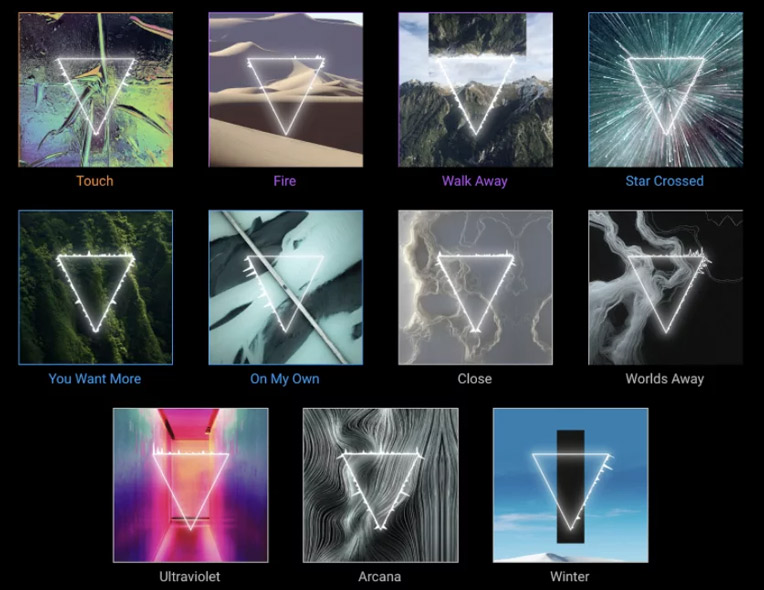
But NFTs aren’t only for musicians and artists.
Top Bilyeu (Impact Theory podcast) developed Founder’s Key in October 2021. On Founder’s Key fans can choose from three NFTs that offer different perks and benefits.
The “Legendary” NFT for example, offers exclusive access to special airdrops, giveaways, discounts at online stores, and even 30 minute monthly calls with Tom.
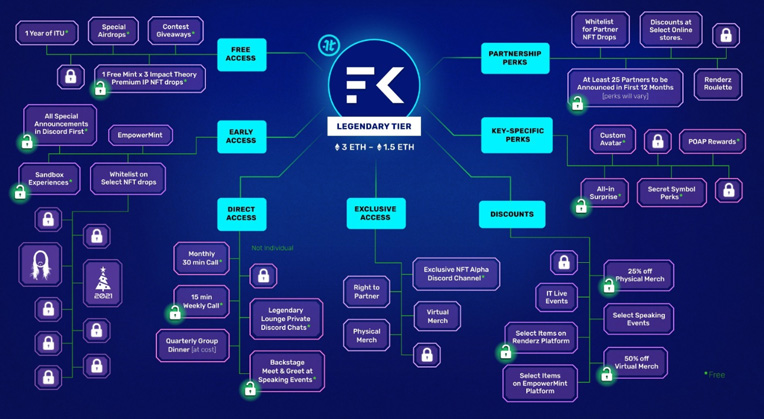
These creators are still a minority in the space.
They are the ones that chose to experiment and use NFTs to create new income streams in different and innovative ways. 2022 is a very exciting year as creators are getting more comfortable with the technology behind NFTs and Web3 and becoming an important component of the creator ecosystem.
6. New types of Creators
The term “Creator” is very broad and applies to a wide variety of people.
YouTubers, podcasters, musicians, artists, designers, streamers, etc. But in 2022, two new types of [professional creators will emerge and become a huge segment of the creator economy:
1. Creators that have separate professional careers
A 2019 survey found that 29% of children in the US want to be YouTubers when they grow up. And in another survey from 2017, 75% of nearly 1000 young people stated that they also want to become YouTube creators.
And since then, the Pandemic has only accelerated this trend.
This of course raises a concern that in the future we won’t have doctors or teachers and professors, because everyone wants to be a content creator. But who’s to say that you can’t be both a creator and have a separate professional career?
This is a new trend in the creator economy, people from a wide range of professions joining the economy and becoming creators with the goal of augmenting their careers instead of replacing them.
For this example, the following three creators are the highlight of 2021:
- Andrew Huberman (professor at Stanford School Of Medicine) – started his podcast on YouTube in 2021 and has now gained almost a million subscribers.
- Doctor Mike – has a YouTube channel with 8.76M subscribers.
- Graham Stephan – investor, real estate agent, and business YouTuber with 3.6M subscribers.
2. Student-athletes
Student-athletes are also in the spotlight as they recently got the right to make money from their names. And with more than half a million student-athletes across the US, they will take on a massive role in the creator economy in 2022.
A new survey done by Inmar Intelligence showed that 85% of 300 agencies, brands, and retail professionals are already planning marketing campaigns with student-athletes with budgets from $500 to more than $50,000.
7. Link-in-bio & cross-platform sharing
Top creators and amateur creators alike have accounts on multiple social platforms.
They publish content across more channels, widen their reach, and grow their audience. Some creators also do this to prevent being de-platformed, as the guidelines of each social media network are always changing.
This trend is so prominent that if you check any influencer you follow on Instagram, you will find that they have social media links in their bio or one link-in-bio link.
Example:
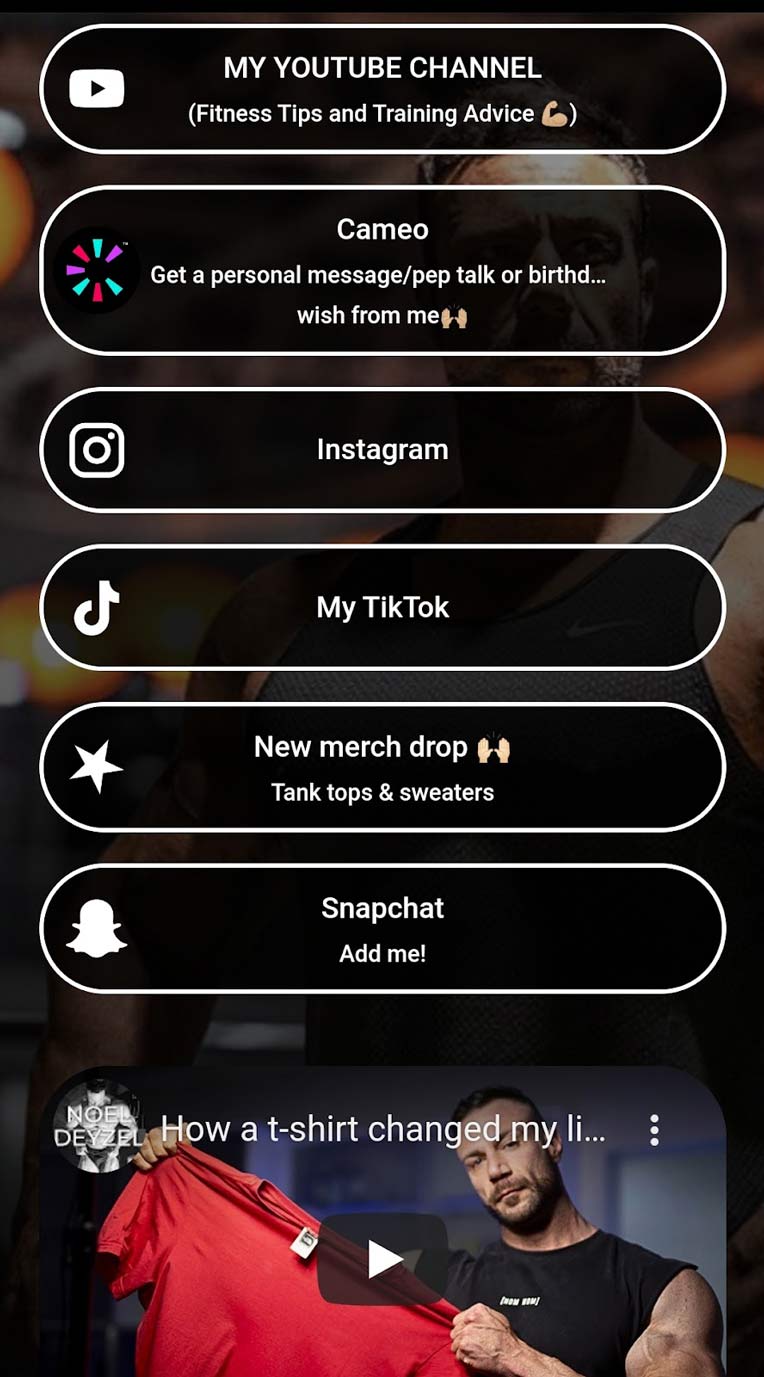
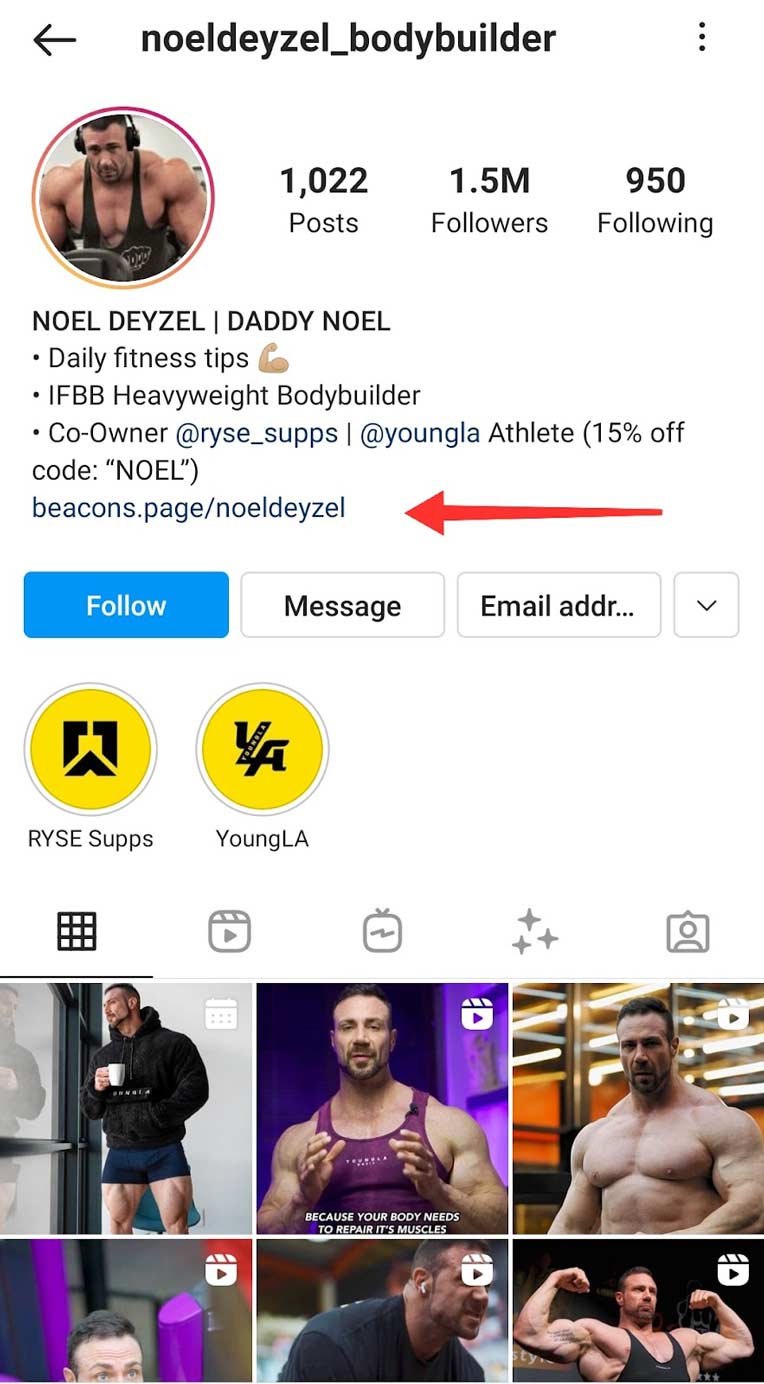
Link-in-bio has been one of the most sought-out tools by creators and investors alike. They not only promote other social platforms but can monetize them with integrations from Shopify, Amazon, Mailchimp, etc.
Creators having multiple social media profiles and link-in-bio links have been one of the strongest ongoing trends in the past few years and will continue to be throughout 2022 as new creators and platforms join the creator economy.
Creator startup Trends
Now that we’ve covered the creator economy trends amongst creators, let’s take a look at the ones amongst creator economy startups.
1. Creator startups using Cold Email Outreach for onboarding new users
This space is still fairly new, and different types of marketing channels are being tested for startup companies to find and capture creators. The most effective way right now is to use a database of relevant creators for mass outreach and send personalized emails using that data.
How do we know this?
In 2021 we worked with more than 40 creator economy companies and startups, including Linktree, Pearpop, Mindvalley, Beacons, Willa, Memmo, and many more, to do just that.
We have the largest creator database on the internet with more than 50M creators, and we help creator economy startups find and onboard the creators they’re targeting. Using extensive filtering by 30 data points we can easily find the perfect creators for any use case.
And not only do we provide leads, but we also have a partnership program for brands that we believe have potential. Here we help with the entire email sending setup by contacting hundreds of thousands of creators each month.
This type of marketing can drastically change the future of a brand. As one of our biggest clients raised $18m based on the results they got using our data.
If you think we might be able to help you do the same, click this link and let’s talk!
2. Mindful investing in the creator economy
With a drop in funding in the creator economy and an upcoming global recession investments are expected to continue but in a more mindful manner as opposed to 2021.
Investors went all out, with record funding of $3.7 billion in the US alone as of October 2021.
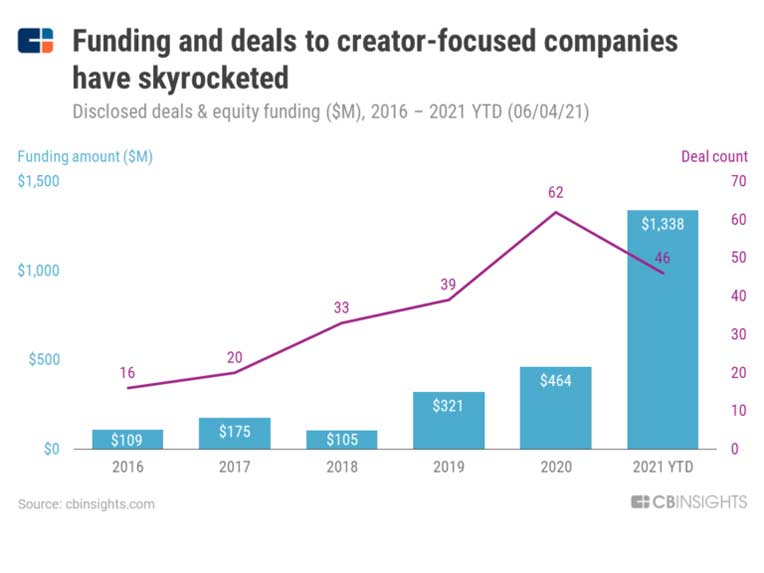
They also say investments could hit $5 billion in 2022.
Throughout 2021 influencer marketing platforms were the biggest attraction for investors. But in 2022, there was a shift to fintech, edtech, management tools, monetization tools, and content distribution (although creator marketing was still very prominent).
However, with the upcoming recession, brands will have tight budgets. Some won’t make it and some will struggle but those who survive will come out stronger. I’ve discussed this with our CEO, Nikola Sokolov in a previous article about creator economy startups.
Some noteworthy investments in 2022 in the mentioned categories:
Some noteworthy investments in 2022 in the mentioned categories:
- Fintech: Willa ($21 million Series A funding) and Superjoi ($2.5 million Pre-seed funding);
- Edtech: Domestika ($154 million Series D funding), Disco ($20.5 million Series A funding);
- Management: Passionfroot ($3.4 million Pre-seed funding), Air ($18 million Series A funding), Stir ($20.69 million Series A funding);
- Monetization: Fanhouse ($33 million Series A funding), Maestro ($22 million Series B funding), VersusGame ($15.8 million Seed funding);
- Content distribution: UnitedMasters ($170 million Series C funding), Filmhub ($6.8 million Seed funding), Curastory ($2.3 million Seed funding).
Creator economy leaders In 2022
These are the main categories and some of the most well-known tools and platforms in the creator economy in 2022:
- Social media platforms: YouTube, Instagram, TikTok, Clubhouse, Twitter, Snapchat, Facebook, and Pinterest.
- Exclusive content platforms: Patreon, Onlyfans, Substack.
- Course & Learning Platforms: Skillshare, Kajabi, and Maven.
- Content Creation Tools: Canva, Kapwing, Photoshop, Facet, Adobe Premiere Pro, Milk Video.
- Monetization Tools & Platforms: Gumroad, Buy me a coffee, Teespring, Cameo, etc.
- Website Builders: Squarespace, Wix, WordPress, Shopify, Weebly, WooCommerce, HubSpot Website Builder, and Web.com.
- NFT Marketplaces: Opensea, Rarible, SuperRare, Foundation, and Melon.
- Streaming Platforms: Twitch.tv, Instagram Live, Youtube Live, Periscope, Livestream, Facebook Live, and Linkedin Live.
What’s in store for 2022
The growth momentum of the creator economy going into 2022 is stronger than ever. And now that you know what to expect, you are fully equipped to leverage every single trend whether you’re a founder looking for ideas, an investor looking for opportunities, or a creator searching for new ways to monetize and grow your audience.

